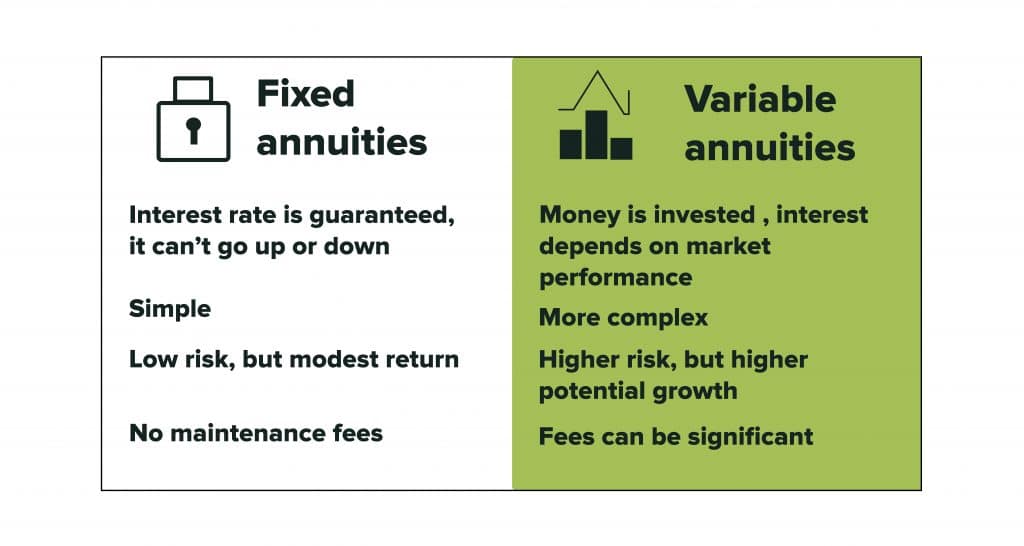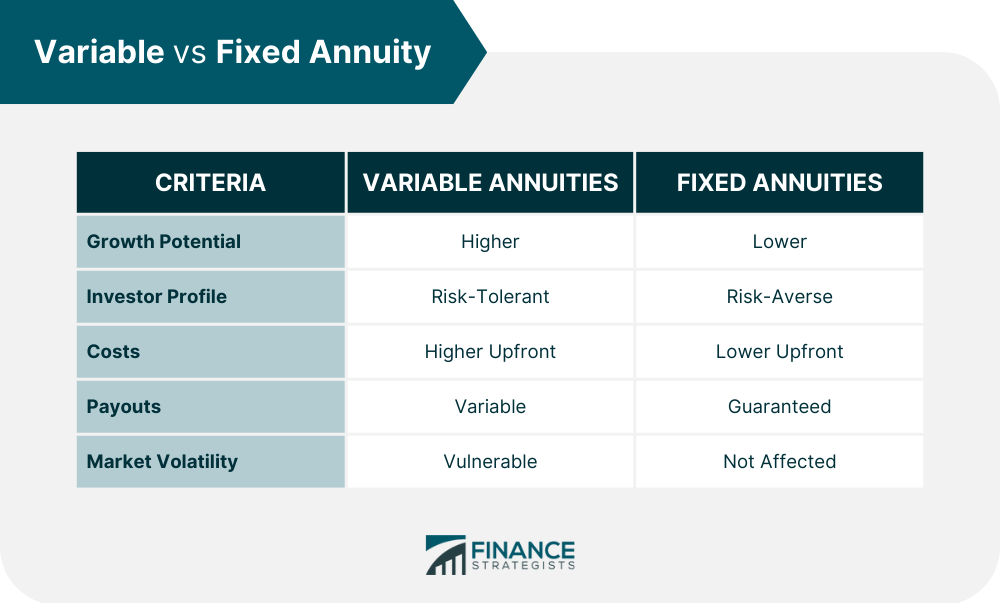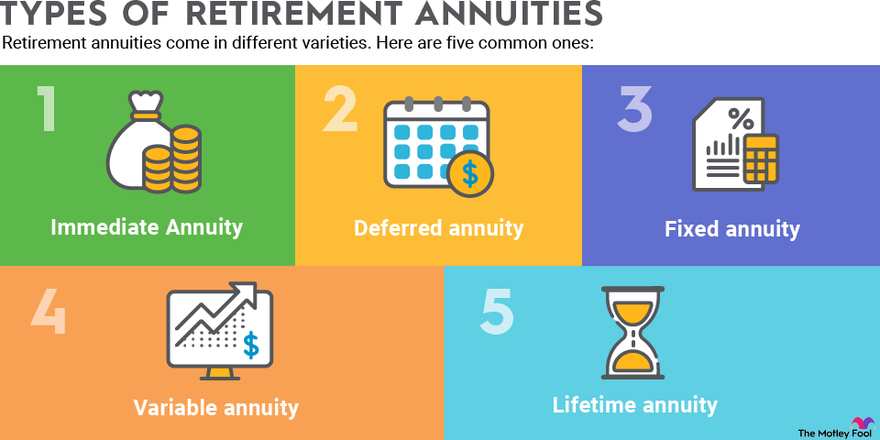All Categories
Featured
Table of Contents
Equally as with a fixed annuity, the owner of a variable annuity pays an insurer a round figure or collection of payments for the pledge of a collection of future payments in return. But as pointed out over, while a fixed annuity grows at a guaranteed, constant price, a variable annuity grows at a variable price that depends upon the performance of the underlying investments, called sub-accounts.

During the build-up stage, possessions bought variable annuity sub-accounts grow on a tax-deferred basis and are exhausted just when the contract proprietor takes out those earnings from the account. After the buildup phase comes the revenue stage. Gradually, variable annuity properties ought to theoretically raise in worth till the agreement owner decides he or she would such as to start taking out money from the account.
The most substantial concern that variable annuities usually existing is high price. Variable annuities have several layers of costs and costs that can, in accumulation, create a drag of up to 3-4% of the contract's value each year.
Understanding Fixed Index Annuity Vs Variable Annuity Key Insights on Your Financial Future Breaking Down the Basics of Investment Plans Advantages and Disadvantages of Fixed Vs Variable Annuity Pros And Cons Why What Is A Variable Annuity Vs A Fixed Annuity Is a Smart Choice How to Compare Different Investment Plans: Explained in Detail Key Differences Between Different Financial Strategies Understanding the Risks of Long-Term Investments Who Should Consider Immediate Fixed Annuity Vs Variable Annuity? Tips for Choosing the Best Investment Strategy FAQs About Variable Vs Fixed Annuities Common Mistakes to Avoid When Planning Your Retirement Financial Planning Simplified: Understanding Fixed Income Annuity Vs Variable Growth Annuity A Beginner’s Guide to Smart Investment Decisions A Closer Look at How to Build a Retirement Plan
M&E cost charges are calculated as a portion of the contract value Annuity companies hand down recordkeeping and various other administrative costs to the agreement owner. This can be in the type of a flat yearly cost or a percentage of the contract worth. Management fees might be included as part of the M&E threat charge or might be analyzed separately.
These charges can range from 0.1% for passive funds to 1.5% or even more for proactively managed funds. Annuity agreements can be tailored in a number of means to serve the certain requirements of the contract proprietor. Some typical variable annuity cyclists include assured minimal buildup benefit (GMAB), ensured minimum withdrawal benefit (GMWB), and guaranteed minimal income benefit (GMIB).

Variable annuity payments give no such tax deduction. Variable annuities have a tendency to be highly inefficient cars for passing wide range to the next generation due to the fact that they do not delight in a cost-basis modification when the original agreement proprietor passes away. When the proprietor of a taxed investment account passes away, the expense bases of the investments kept in the account are adapted to reflect the marketplace rates of those financial investments at the time of the proprietor's fatality.
Analyzing Strategic Retirement Planning Key Insights on Fixed Interest Annuity Vs Variable Investment Annuity What Is Fixed Index Annuity Vs Variable Annuities? Pros and Cons of Various Financial Options Why Fixed Index Annuity Vs Variable Annuities Matters for Retirement Planning Variable Annuity Vs Fixed Indexed Annuity: Simplified Key Differences Between Variable Annuity Vs Fixed Indexed Annuity Understanding the Key Features of Indexed Annuity Vs Fixed Annuity Who Should Consider Choosing Between Fixed Annuity And Variable Annuity? Tips for Choosing the Best Investment Strategy FAQs About Planning Your Financial Future Common Mistakes to Avoid When Planning Your Retirement Financial Planning Simplified: Understanding Your Options A Beginner’s Guide to Fixed Income Annuity Vs Variable Annuity A Closer Look at What Is Variable Annuity Vs Fixed Annuity
Beneficiaries can inherit a taxable investment portfolio with a "clean slate" from a tax perspective. Such is not the instance with variable annuities. Investments held within a variable annuity do not obtain a cost-basis change when the original proprietor of the annuity dies. This means that any collected unrealized gains will certainly be passed on to the annuity owner's beneficiaries, in addition to the linked tax concern.
One considerable concern connected to variable annuities is the capacity for conflicts of interest that may feed on the part of annuity salespeople. Unlike a financial consultant, that has a fiduciary obligation to make investment choices that profit the client, an insurance policy broker has no such fiduciary responsibility. Annuity sales are highly rewarding for the insurance coverage experts that sell them due to high upfront sales commissions.

Many variable annuity contracts have language which puts a cap on the portion of gain that can be experienced by particular sub-accounts. These caps prevent the annuity proprietor from completely taking part in a section of gains that might otherwise be enjoyed in years in which markets create significant returns. From an outsider's point of view, it would certainly seem that financiers are trading a cap on financial investment returns for the previously mentioned assured flooring on investment returns.
As noted over, give up fees can seriously limit an annuity owner's capacity to relocate assets out of an annuity in the early years of the contract. Better, while the majority of variable annuities enable contract owners to take out a defined quantity throughout the buildup stage, withdrawals past this amount generally result in a company-imposed cost.
Withdrawals made from a fixed rates of interest financial investment choice could also experience a "market price adjustment" or MVA. An MVA changes the worth of the withdrawal to mirror any adjustments in rates of interest from the time that the cash was bought the fixed-rate alternative to the time that it was taken out.

Frequently, even the salespeople that market them do not completely understand just how they work, and so salesmen in some cases take advantage of a buyer's feelings to sell variable annuities rather than the benefits and viability of the items themselves. Our company believe that financiers must fully understand what they have and just how much they are paying to have it.
Understanding Pros And Cons Of Fixed Annuity And Variable Annuity Everything You Need to Know About Financial Strategies What Is the Best Retirement Option? Pros and Cons of Various Financial Options Why Choosing the Right Financial Strategy Is a Smart Choice Fixed Vs Variable Annuity Pros And Cons: How It Works Key Differences Between Different Financial Strategies Understanding the Key Features of Long-Term Investments Who Should Consider Pros And Cons Of Fixed Annuity And Variable Annuity? Tips for Choosing Fixed Vs Variable Annuities FAQs About Planning Your Financial Future Common Mistakes to Avoid When Planning Your Retirement Financial Planning Simplified: Understanding Fixed Annuity Vs Variable Annuity A Beginner’s Guide to Smart Investment Decisions A Closer Look at How to Build a Retirement Plan
The same can not be claimed for variable annuity possessions held in fixed-rate investments. These assets legitimately come from the insurance firm and would as a result go to threat if the business were to fail. Similarly, any kind of warranties that the insurance provider has actually accepted give, such as a guaranteed minimal revenue benefit, would be in inquiry in the occasion of a company failing.
Prospective purchasers of variable annuities must comprehend and consider the monetary problem of the issuing insurance firm before getting in into an annuity contract. While the benefits and drawbacks of numerous kinds of annuities can be debated, the real concern bordering annuities is that of viability.
Nevertheless, as the stating goes: "Caveat emptor!" This short article is prepared by Pekin Hardy Strauss, Inc. Best annuities for long-term planning. ("Pekin Hardy," dba Pekin Hardy Strauss Wide Range Monitoring) for educational functions only and is not meant as an offer or solicitation for business. The details and data in this write-up does not make up legal, tax, bookkeeping, investment, or other specialist guidance
Table of Contents
Latest Posts
Highlighting the Key Features of Long-Term Investments A Closer Look at How Retirement Planning Works What Is Variable Vs Fixed Annuities? Pros and Cons of Various Financial Options Why Choosing the R
Analyzing Strategic Retirement Planning Everything You Need to Know About Tax Benefits Of Fixed Vs Variable Annuities What Is the Best Retirement Option? Pros and Cons of Fixed Index Annuity Vs Variab
Decoding How Investment Plans Work Everything You Need to Know About Financial Strategies Defining the Right Financial Strategy Pros and Cons of Fixed Interest Annuity Vs Variable Investment Annuity W
More
Latest Posts